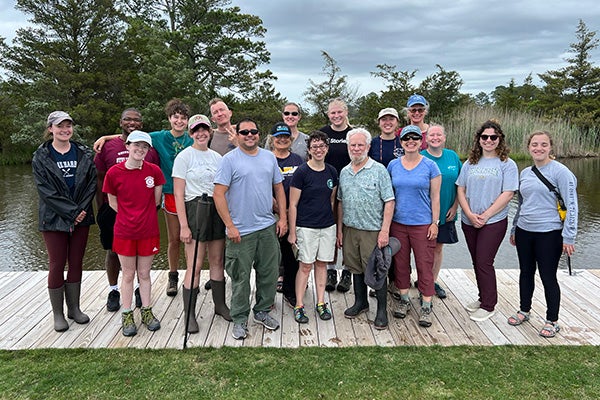ECU involved in first-ever survey of marine bioinvasions from the mid-Atlantic
Warming waters along the mid-Atlantic coast may be contributing to significant changes in the composition of marine species located in the area. Certain non-native creatures can create havoc, covering the bottoms of boats, docks and piers, requiring frequent cleaning and maintenance.
An East Carolina University faculty member and student are part of a group of scientists investigating these non-native marine species in the first-ever Marine Bioinvasions Rapid Assessment Survey (RAS) of mid-Atlantic marinas.

East Carolina University associate professor April M.H. Blakeslee and graduate student Carter K. Stancil were participants of the first-ever Marine Bioinvasions Rapid Assessment Survey of mid-Atlantic marinas. (Contributed photos)
Dr. April M.H. Blakeslee, associate professor of biology in the Thomas Harriot College of Arts and Sciences, and biology graduate student Carter K. Stancil, spent five days in June sampling floating docks in 10 busy recreational marinas along more than 200 miles of coastline from Virginia to New Jersey. The effort involved 18 marine biologists and students from the eastern United States.
“The purpose of the research was to create a modern-day baseline of non-native biofouling species in the face of rapid climate and habitat changes and increasing global and coastal shipping traffic,” Blakeslee said. “Monitoring which non-native species may be increasing and which new species are arriving is a fundamental requirement for coastal management officials, as well as port and harbor officers needing to keep their fingers on the pulse of continually changing ecosystems.”
Blakeslee said that sea squirts and seaweeds are particularly dominant in coastal waters and that they can create substantial biofouling communities covering docks, piers and boat bottoms. According to Blakeslee, biofouling — the accumulation of organic material that could cause structural damage, like barnacles on a buoy — often requires frequent cleaning and maintenance of infrastructures and may be increasing in certain regions with warming waters.
“There have only been a few previously published biofouling studies in the region, but they were highly localized and largely conducted 50 years ago. However, our work, in addition to recent work completed eight years ago, suggests that significant changes in species composition have likely occurred,” she said. “Among the 25 non-native species of sea anemones, worms, crustaceans, sea squirts, other invertebrates and seaweeds documented during the RAS, more than a half-dozen non-native species were not previously known from mid-Atlantic waters.”
RAS scientists also found that non-native species were among the most abundant species at nine of the 10 communities sampled from the lower Delmarva Peninsula in Virginia to Sandy Hook Bay in northern New Jersey.
While Blakeslee said that many of the detected species remain to be identified, significant new records of “Caribbean Creep” species – southern species moving up into the warming waters of the mid-Atlantic U.S. seaboard – were found, along with new records of Asian species that were first detected in New England and are now expanding southward to their natural temperature tolerances.
Among the discoveries were a large mushroom-shaped sea squirt, Distaplia, a group previously published as occurring no further north than Florida and the Caribbean, but now found in Virginia, and a golf-ball-sized sea squirt, Styela plicata, native to Asia, now expanding north from Virginia to Maryland.
Funding for the RAS was supported by a Delaware Sea Grant, Maryland Sea Grant, Virginia Sea Grant, the Virginia Academy of Sciences, the Mid-Atlantic Panel on Aquatic Invasive Species, and The International Association for Open Knowledge on Invasive Alien Species, with additional support from George Mason University, ECU’s Water Resources Center and Williams College. Host laboratories supplying research space for the RAS expedition included the Virginia Institute of Marine Science’s Eastern Shore Laboratory in Wachapreague, the University of Delaware College of Earth, Ocean, and Environment Hugh R. Sharp Campus’ Pollution Ecology Laboratory in Lewes, and the Stockton University Marine Field Station in Port Republic, New Jersey.
Participating scientists were from George Mason University, East Carolina University, MIT Sea Grant Program, the North Carolina Museum of Natural Sciences, Salve Regina University, the Smithsonian Environmental Research Center, the University of Rhode Island, Wheaton College and the Williams College-Mystic Seaport Coastal and Ocean Studies Program.